Guitar Accessories That Will Take Your Playing to the Next Level
Listen to the Audio “Essential Guitar Accessories”
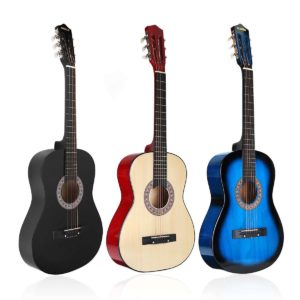
Are you ready to elevate your guitar playing to new heights? In this article, we will introduce you to must-have guitar accessories that will take your playing to the next level.
Whether you are a beginner or an experienced guitarist, these accessories are essential for enhancing your sound, improving your technique, and providing you with endless inspiration. From high-quality guitar picks and straps to versatile effect pedals and state-of-the-art tuners, we’ve got you covered. Discover how a simple capo can unlock new possibilities and explore the world of guitar effects with a versatile pedalboard setup.
Whether you’re playing acoustic or electric guitar, these accessories will help you achieve the tone and style you desire. So, get ready to upgrade your gear and unleash your true potential as a guitarist. Let’s dive in and discover the must-have guitar accessories that will revolutionize your playing experience.
Essential accessories for every guitarist
Every guitarist, whether beginner or expert, needs some essential accessories to make their playing experience more enjoyable and comfortable. Here are some of the most important ones:
– Guitar Strings, String Winder and String Cutter
If you are a guitar player, you know how important it is to have good quality strings on your instrument. Strings affect the sound, the feel and the playability of your guitar. But strings also wear out over time and need to be replaced regularly. That’s why you need a string winder and a string cutter, two essential tools for changing your guitar strings.
A string winder is a device that helps you tighten or loosen the tuning pegs of your guitar. It has a handle and a head that fits over the pegs. By turning the handle, you can wind or unwind the strings faster and easier than by hand. A string winder saves you time and effort when changing your strings, and also prevents damage to the pegs or the headstock of your guitar.
A string cutter is a tool that helps you cut off the excess length of your new strings after you have installed them on your guitar. It has a sharp blade and a handle that allows you to grip it firmly. By squeezing the handle, you can snip off the extra string with one clean cut. A string cutter saves you space and hassle when changing your strings, and also prevents injury or damage from the sharp ends of the strings.
To change your guitar strings, you will need a new set of strings, a string winder, a string cutter, and a cloth or a rag. Here are the steps to follow:
- Loosen the old strings using the string winder. Turn the tuning pegs counter clockwise until the strings are slack enough to remove from the bridge and the headstock.
- Cut off the old strings using the string cutter. Be careful not to scratch or dent your guitar with the blade. Dispose of the old strings properly.
- Clean your guitar using the cloth or rag. Wipe off any dust, dirt or sweat from the body, the neck and the fretboard of your guitar. You can also use some guitar polish or lemon oil to make your guitar shine and protect it from moisture and corrosion.
- Install the new strings one by one. Start with the thickest string (the low E) and work your way to the thinnest string (the high E). Thread one end of the string through the hole in the bridge and pull it through until it reaches the corresponding tuning peg. Make sure to leave some slack for winding.
- Wind the new string using the string winder. Turn the tuning peg clockwise until the string is tight enough to produce a clear tone. Make sure to wind the string neatly around the peg, without overlapping or crossing over itself.
- Cut off the excess string using the string cutter. Leave about an inch of string beyond the tuning peg for safety and stability. Bend the end of the string slightly downward to prevent it from poking out or hurting you.
- Repeat steps 4 to 6 for each of the remaining strings.
- Tune your guitar using a tuner, a pitch pipe or another instrument. Check each string for accuracy and adjust it as needed using the string winder.
- Stretch your new strings by gently pulling them away from the fretboard with your fingers. This will help them settle in and stay in tune longer.
- Enjoy playing your guitar with fresh new strings!
Changing your guitar strings is an easy and rewarding process that will improve your sound and performance. With a string winder and a string cutter, you can do it quickly and efficiently without any hassle or trouble. Make sure to change your strings regularly to keep your guitar in top shape and sounding great!
– A Tuner and Metronome
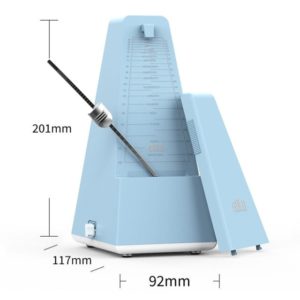
A tuner and metronome are essential tools for musicians of any level. A tuner is a device that helps you tune your guitar strings to the correct pitch. Tuning your guitar regularly is crucial for maintaining its sound quality and avoiding unwanted noises. You can use a clip-on tuner that attaches to your guitar headstock, a pedal tuner that connects to your guitar cable, or a smartphone app that uses your device’s microphone.
Metronomes help to keep a steady tempo or rhythm while practicing or performing music. Both tuners and metronomes can be found in various forms, such as digital devices, apps, online tools, or mechanical devices.
Tuners and metronomes have many benefits for musical development and performance. Tuners can improve intonation, accuracy, and ear training skills, as well as prevent damage to instruments due to improper tuning. Metronomes can improve timing, coordination, speed, and accuracy, as well as develop a sense of groove and musical expression. Tuners and metronomes can also help musicians to play in tune and in time with other musicians, which is crucial for ensemble playing.
Tuners and metronomes are widely available and affordable, and they should be used regularly by musicians who want to improve their skills and sound quality. Tuners and metronomes are not only useful for beginners, but also for advanced and professional musicians who want to maintain and refine their musical abilities. Tuners and metronomes are not meant to replace the human ear or the musical feel, but rather to enhance them and provide feedback and guidance.
– A Capo
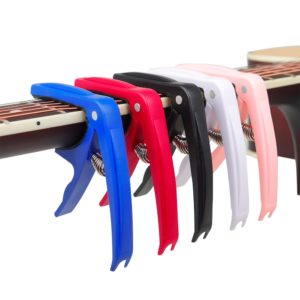
A capo is a device that clamps onto the neck of a guitar and shortens the length of the strings, changing their pitch. It allows guitarists to play songs in different keys without having to change the tuning of the guitar or learn new chord shapes. A capo can also create different tonal qualities and effects, depending on where it is placed on the fretboard. Some common types of 6 string capos are spring-loaded, screw-type, and trigger-type. Each type has its own advantages and disadvantages, such as ease of use, pressure, and durability. A capo can be a useful tool for guitar players of all levels, as it can expand their musical repertoire and creativity.
– A Strap
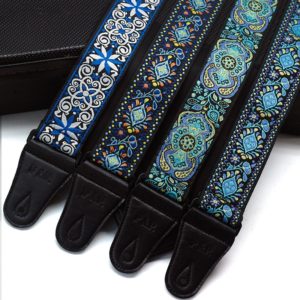
A strap is a piece of fabric or leather that you can attach to your guitar body and wear over your shoulder to hold your guitar while standing or moving around. A strap can help you avoid dropping your guitar, improve your posture, and free your hands for other tasks. You should choose a strap that is comfortable, durable, and adjustable to fit your body size and guitar shape.
However, not all guitar straps are created equal, and some may not fit your guitar well or may wear out quickly. That’s why you need to consider using strap locks, which are devices that secure your strap to your guitar and prevent it from coming off accidentally. Strap locks can save you from potential damage to your guitar or injury to yourself or others.
There are different types of strap locks available, such as screw-in, push-button, clip-on, or locking strap. Each type has its own advantages and disadvantages, depending on your preferences and needs. Some factors to consider when choosing a strap lock are ease of installation, durability, compatibility, aesthetics, and cost. You should also make sure that the strap lock matches the size and shape of your strap button, which is the part of your guitar where the strap attaches.
– A Pick and Pick Holder
Guitar picks and pick holders are essential accessories for any guitarist who wants to play with precision, comfort and style. Guitar picks, also known as plectrums, are small, flat pieces of plastic, metal, wood or other materials that are used to pluck or strum the strings of a guitar. They come in various shapes, sizes, thicknesses and colours to suit different preferences and playing styles.
Guitar pick holders are devices that attach to the guitar, the strap, the microphone stand or other places to store and organize guitar picks. They help guitarists to easily access their picks during a performance or a practice session, and to avoid losing or dropping them. Some guitar pick holders also have features such as magnets, springs or clips to secure the picks in place.
Guitar picks and pick holders are relatively inexpensive, but they can make a big difference in the sound quality, the ease of playing and the appearance of a guitarist. They are widely available in music stores, online shops and other places where guitars are sold.
– A Case or Gig Bag
A case or gig bag is a protective cover that you can use to store and transport your guitar safely. A case or gig bag can protect your guitar from dust, dirt, moisture, scratches, dents, and other damages. You should choose a case or gig bag that fits your guitar size and shape, has enough padding and cushioning, and has enough pockets and compartments for your other accessories.
Guitar cases and gig bags are essential accessories for any guitarist who wants to protect their instrument and transport it safely. There are many types of cases and bags available, each with different features, benefits and drawbacks. Here are some factors to consider when choosing a guitar case or gig bag:
- Size and shape: The case or bag should fit your guitar snugly, without leaving too much space or putting too much pressure on the instrument. You should also consider the size and shape of your guitar, as some cases and bags are designed for specific models or styles of guitars. For example, if you have an acoustic guitar, you may want a case or bag that has extra padding or compartments for accessories like tuners, capos or picks.
- Material and durability: The case or bag should be made of sturdy and durable material that can withstand wear and tear, impacts, scratches and moisture. Some common materials are wood, hard plastic, metal, leather, nylon and canvas. Each material has its own advantages and disadvantages in terms of weight, protection, appearance and price. For example, wood cases are usually heavier but offer more protection than nylon bags, while leather cases are more expensive but look more elegant than canvas bags.
- Features and convenience: The case or bag should have features that make it easy and convenient to use, such as handles, straps, zippers, locks, pockets and wheels. You should also consider how often and how far you travel with your guitar, as some features may be more useful than others depending on your needs. For example, if you fly frequently with your guitar, you may want a case that has TSA-approved locks or wheels for easy mobility, while if you only play at home or nearby venues, you may prefer a bag that has more pockets for storing extra strings or cables.
– Guitar Stands and Wall Mounts
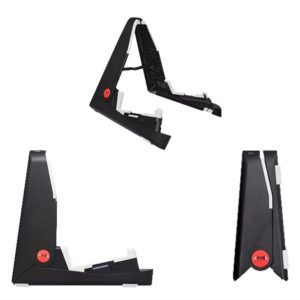
Guitar stands and wall mounts are essential accessories for any guitar player who wants to store and display their instruments safely and securely. There are many types of guitar stands and wall mounts available, each with its own advantages and disadvantages. In this article, we will compare some of the most popular options and help you choose the best one for your needs.

Guitar stands are freestanding devices that hold your guitar upright on the floor or on a table. They usually have a base, a neck support, and a body support that cradle your guitar and prevent it from falling over. Some guitar stands are foldable, making them easy to transport and store. Some guitar stands also have locking mechanisms or straps that secure your guitar in place.
Wall mounts are brackets that attach to your wall and hold your guitar horizontally or vertically. They usually have a padded arm that hooks onto your guitar’s headstock or body, depending on the orientation. Some wall mounts are adjustable, allowing you to change the angle and position of your guitar. Some wall mounts also have locking mechanisms or straps that secure your guitar in place.
Both stands and wall mounts have pros and cons that you should consider before buying one. Here are some of the factors to keep in mind:
- Space: Guitar stands take up more floor space than wall mounts, which can be an issue if you have a small room or a lot of guitars. Wall mounts save floor space, but they require drilling holes in your wall, which can be a hassle if you rent or move frequently.
- Visibility: Guitar stands display your guitar more prominently than wall mounts, which can be a plus if you want to show off your collection or inspire yourself to play more often. Wall mounts display your guitar more discreetly than stands, which can be a plus if you want to avoid clutter or distraction.
- Accessibility: Guitar stands make your guitar more accessible than wall mounts, as you can easily grab it and play whenever you want. Wall mounts make your guitar less accessible than stands, as you have to unhook it and hook it back every time you use it.
- Stability: Guitar stands are more stable than wall mounts, as they have a wider base and a lower centre of gravity. Wall mounts are less stable than stands, as they depend on the strength of the wall and the screws. If the wall is weak or the screws are loose, your guitar could fall off and get damaged.
- Protection: Guitar stands protect your guitar better than wall mounts, as they prevent it from bumping into other objects or people. Wall mounts protect your guitar worse than stands, as they expose it to dust, humidity, sunlight, and temperature changes, which can affect its sound and appearance.
As you can see, there is no definitive answer to which type of guitar stand or wall mount is better. It depends on your personal preference, budget, space, and style. The best thing to do is to try out different options and see what works best for you and your guitar.
-
Guitar Cables
Guitar cables are essential components of any electric guitar setup. They connect the guitar to the amplifier, pedalboard, or audio interface, and transmit the signal from the pickups to the output device. Guitar cables come in different lengths, diameters, materials, and connectors, and each of these factors can affect the sound quality, durability, and performance of the cable. In this article, we will discuss some of the main features and benefits of guitar cables, and how to choose the best one for your needs.
-
A guitar Amplifier
A guitar amplifier is an electronic device that amplifies the sound of an electric guitar or an acoustic guitar with a pickup. Guitar amplifiers can have various features, such as tone controls, effects, reverb, distortion, and feedback.
Guitar amplifiers are designed to produce different sounds for different musical genres and styles. Some guitar amplifiers are specialized for certain types of guitars, such as bass guitars, acoustic guitars, or electric guitars.
Guitar amplifiers can be classified into two main types: combo amps and stack amps. Combo amps combine the amplifier and the speaker in one unit, while stack amps consist of a separate amplifier head and one or more speaker cabinets. Combo amps are more portable and convenient, while stack amps offer more power and flexibility.
-
Effects Pedals and Pedal Tuners
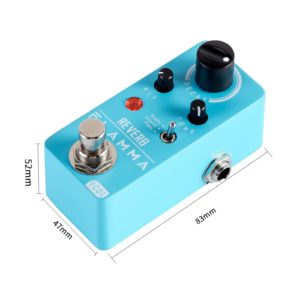
Effects pedals and pedal tuners are devices that modify the sound of electric guitars, basses, keyboards, and other instruments. They can create a variety of effects, such as distortion, chorus, delay, reverb, and more. Pedal tuners are used to tune the instrument quickly and accurately by displaying the pitch of the input signal on a screen.
Effects pedals and pedal tuners can be connected in series or in parallel, depending on the desired sound and signal flow. In series, the output of one pedal goes into the input of another, creating a chain of effects. In parallel, the pedals are connected to a splitter or a mixer, allowing each effect to process the signal independently and then combine them at the end.
Conclusion to Essential Guitar Accessories
To sum up, essential guitar accessories are those that enhance your playing experience, protect your instrument, and help you achieve your musical goals. Some of the most important accessories are guitar picks, strings, straps, tuners, capos, stands, cases, and cables. Depending on your style, skill level, and preferences, you may also want to invest in other accessories such as pedals, amps, slides, or humidifiers.
Whatever you choose, make sure you do your research and find the best quality products that suit your needs and budget. Remember, guitar accessories are not just optional extras; they are vital tools that can make a difference in your sound and performance.
